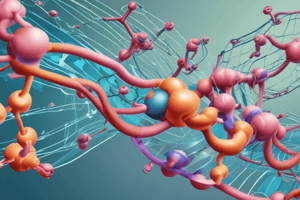Podcast
Questions and Answers
What is the primary (1°) structure of a protein?
What is the primary (1°) structure of a protein?
Linear sequence of amino acid residues in order they are joined along its polypeptide chain.
What are the two most common patterns of secondary (2°) structure in proteins?
What are the two most common patterns of secondary (2°) structure in proteins?
- Carbonyl and Hydrogen
- Glycine and Proline
- Leucine and Isoleucine
- Alpha-helix and Beta-pleated sheet (correct)
The tertiary structure of a protein refers to its unique three-dimensional conformation.
The tertiary structure of a protein refers to its unique three-dimensional conformation.
True (A)
_______ structure of proteins consists of 2 or more polypeptide chains united by forces other than covalent bonds.
_______ structure of proteins consists of 2 or more polypeptide chains united by forces other than covalent bonds.
Which force plays a key role in maintaining the structure and conformation of proteins?
Which force plays a key role in maintaining the structure and conformation of proteins?
What is renaturation in the context of proteins?
What is renaturation in the context of proteins?
Which of the following are denaturing conditions for proteins? (Select all that apply)
Which of the following are denaturing conditions for proteins? (Select all that apply)
Proteins are amphoteric, meaning they can act as both acid and base.
Proteins are amphoteric, meaning they can act as both acid and base.
Proteins exist as 'cation complex' in _______ solution.
Proteins exist as 'cation complex' in _______ solution.
What does a protein form when titrated with alkali?
What does a protein form when titrated with alkali?
Which factor can induce protein crystallization?
Which factor can induce protein crystallization?
Study Notes
Protein Structure and Function
- Proteins are polypeptides that contain approximately 50 or more amino acid residues linked together via peptide covalent bonds.
- Proteins must coil or fold in a specific manner to be biologically active.
Functions of Proteins
- Catalysis: Enzymes regulate and accelerate biochemical processes such as digestion and biosynthesis.
- Structure: Collagen and elastin provide mechanical strength and elasticity to connective tissues.
- Cellular movement: Actin, tubulin, and other proteins form the cytoskeleton, important for cell division, endocytosis, exocytosis, and lymphocyte movement.
- Mobility: Actin and myosin filaments are involved in muscle contraction.
- Defence: Keratin protects the organism against mechanical and chemical injury, while immunoglobulins protect against foreign organisms.
- Regulation: Hormones such as insulin and glucagon regulate blood glucose levels.
- Vision: Rhodopsin in the human eye initiates visual signal transmission to the brain.
- Transport: Glucose transporters, hemoglobin, lipoproteins, and transferrin transport molecules and ions.
- Storage: Ovalbumin in bird eggs and casein in mammalian milk store nutrients.
- Stress response: Cytochrome P450 converts toxic contaminants to less toxic derivatives, while heat shock proteins promote correct protein folding or degradation.
Classification of Proteins
- Based on shape and composition:
- Fibrous proteins: Long, rod-shaped, insoluble in water, and tough (e.g., keratin).
- Globular proteins: Compact, spherical, water-soluble, and not tough (e.g., hemoglobin).
- Based on composition:
- Simple proteins: Contain only amino acids (e.g., keratin and serum albumin).
- Conjugated proteins: Combine a simple protein with a non-protein component (e.g., glycoproteins, metalloproteins, and lipoproteins).
Protein Structure
- Primary (1°) structure: Linear sequence of amino acid residues joined by peptide bonds.
- Secondary (2°) structure:
- α-helix: Rigid rod-like structure with polypeptide chain twisted into a right-handed helix.
- β-pleated sheet: Parallel or antiparallel polypeptide chains with hydrogen bonds between N-H and C=O groups.
Motifs
- Combinations of α-helix and β-pleated sheets in globular proteins.
- Examples: βαβ motif, β-meander (β-hairpin), αα unit, and β-barrel.
Tertiary Structure
- Unique three-dimensional conformation of globular proteins.
- Forces stabilizing tertiary structure: Hydrophobic interactions, hydrogen bonds, disulfide bonds, and electrostatic interactions.
Quaternary (4°) Structure
- Not all proteins have quaternary structure.
- Proteins with quaternary structure consist of 2 or more polypeptide chains united by non-covalent forces.
Protein Denaturation and Renaturation
- Denaturation: Disruption of protein structure, often resulting in loss of biological activity.
- Renaturation: Refolding of denatured protein into its native conformation.
Physicochemical Properties of Proteins
- Amphoterism: Proteins can act as acids or bases.
- Existence as "cation complex" in acidic solutions.
- Ability to form zwitterions and anions when titrated with alkali.
- Ability to be crystallized.
Studying That Suits You
Use AI to generate personalized quizzes and flashcards to suit your learning preferences.
Description
This quiz covers the different levels of protein structure, the types of linkages involved, and their physicochemical properties. It also explores the denaturation and renaturation processes and the properties of denatured proteins.




